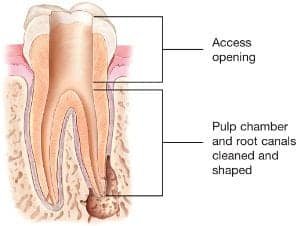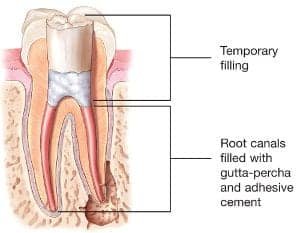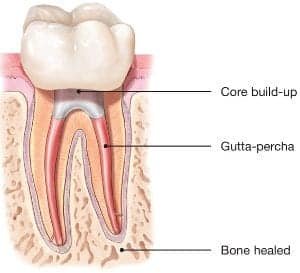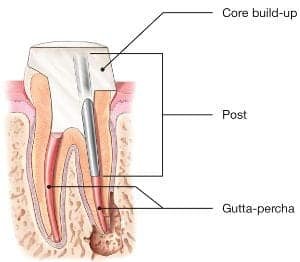Frequently Asked Questions (FAQ)
All FAQ’s are kindly attributed to The British Endodontic Society (BES) and The American Association of Endodontics (AAE)

-
-
“Endo” is the Greek word for “inside” and “odont” is Greek for “tooth.” Endodontic treatment treats the inside of the tooth. Root canal treatment is one type of endodontic treatment.
To understand endodontic treatment, it helps to know something about the anatomy of the tooth. Inside the tooth, under the white enamel and a hard layer called the dentin, is a soft tissue called the pulp. The pulp contains blood vessels, nerves and connective tissue and creates the surrounding hard tissues of the tooth during development.
The pulp extends from the crown of the tooth to the tip of the roots where it connects to the tissues surrounding the root. The pulp is important during a tooth’s growth and development. However, once a tooth is fully mature it can survive without the pulp, because the tooth continues to be nourished by the tissues surrounding it. Learn more about exactly what a root canal is.
-
There are a few symptoms that mean you might need a root canal:
• Severe pain while chewing or biting.
• Pimples on the gums.
• A chipped or cracked tooth.
• Lingering sensitivity to hot or cold, even after the sensation has been removed.
• Swollen or tender gums.
• Deep decay or darkening of the gums. -
The endodontist removes the inflamed or infected pulp, carefully cleans and shapes the inside of the root canal, then fills and seals the space. Afterward, you will return to your dentist, who will place a crown or other restoration on the tooth to protect and restore it to full function. After restoration, the tooth continues to function like any other tooth.
-
Many endodontic procedures are performed to relieve the pain of toothaches caused by pulp inflammation or infection. With modern techniques and anesthetics, most patients report that they are comfortable during the procedure.
For the first few days after treatment, your tooth may feel sensitive, especially if there was pain or infection before the procedure. This discomfort can be relieved with over the counter or prescription medications. Follow your endodontist’s instructions carefully.
Your tooth may continue to feel slightly different from your other teeth for some time after your endodontic treatment is completed. However, if you have severe pain or pressure or pain that lasts more than a few days, call your endodontist.
Step-by-Step Endodontic Procedure
Endodontic treatment can often be performed in one or two visits and involves the following steps:
Step 1
The endodontist examines and takes a radiograph of the tooth using x-rays, then administers local anesthetic. After the tooth is numb, the endodontist places a small protective sheet called a “dental dam” over the area to isolate the tooth and keep it clean and free of saliva during the procedure.
Step 2
The endodontist makes an opening in the crown of the tooth. Very small instruments are used to clean the pulp from the pulp chamber and root canals and to shape the space for filling.
Step 3
After space is cleaned and shaped, the endodontist fills the root canals with a biocompatible material, usually a rubber-like material called gutta-percha. The gutta-percha is placed with an adhesive cement to ensure complete sealing of the root canals. In most cases, a temporary filling is placed to close the opening. The temporary filling will be removed by your dentist before the tooth is restored.
Step 4
After the final visit with your endodontist, you must return to your dentist to have a crown or other restoration placed on the tooth to protect and restore it to full function.
If the tooth lacks sufficient structure to hold the restoration in place, your dentist or endodontist may place a post inside the tooth. Ask your dentist or endodontist for more details about the specific restoration planned for your tooth.
Patient Journey
-
If you are a registered patient your dentist can refer to me directly.
—
Once I have received the referral the practice will contact you.
—
We will book an appointment to see you and discuss the treatment, prognosis, and provide an estimate.
—
We will arrange the root canal treatment.
—
We will return you to your dentist for the final restoration. -
If you do not have a dentist, already please send me a message and the practice will contact you to discuss your treatment needs.





